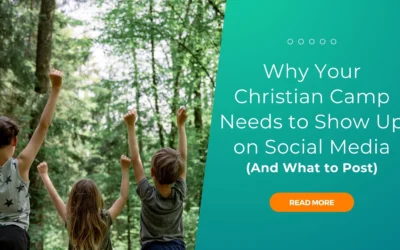Why Your Christian Camp Website Matters More Than Ever
What’s the #1 thing that Christian camps need to work on? Interestingly, as we’ve talked to many people about the Christian camp niche, many of them have said that it’s their website.
It’s clear to me—maybe because of my eye for design, or because this is my area of expertise—that this industry is experiencing an identity crisis. It’s being limited by an outdated digital presence (for example, websites that are 15+ years old and contain outdated information).
This is a major reason larger camps—with cutting edge websites—continue growing, while smaller camps, with outdated sites or no website, are slowly disappearing.
In this digital era, parents are able to compare and consider various Christian camps online, usually opening 3 or 4 website tabs at a time. They expect to see and learn everything they need in order to feel confident and comfortable sending their children to camp.
As experts in web design and development, and a CCCA member working with Christian Camps, we’ve seen the best (and worst!) of what works online.
What Makes a Great Christian Camp Website in 2025?
1. Mobile-First and Fast-Loading = First Impressions That Stick
Like I said, if we are talking about a 15-year-old website, or even a 10-year-old website, mobile wasn’t that big of deal yet. But now, more than ever, your website needs to be aligned with your target audience. I don’t have to tell you that parents and children are spending more time than ever on their devices.
It’s essential that websites load quickly, contain accurate information, and improve user experience for those searching for a summer or winter camp for their children. Some may even leverage AI for recommendations.
One of Lifedge’s key emphases in website design and development for Christian camps is ensuring your website performs well on mobile devices and loads quickly. This is a first impression that sticks.
Can you think of the last time you waited more than 7 seconds for a website? Probably not. And this is the reality for many Christian camp websites out there. They have outdated websites that don’t load well on mobile devices, lack SEO friendliness, and utterly fail to provide a positive user experience.
If you would like to see how your website scores in these areas, we recommend going to the Google’s Core Web Vitals. Enter your Christian Camp URL and, when you’re ready, share your scores with us for a full analysis and interpretation of your results.
2. Clear Messaging That Connects with Families and Donors
Let’s test your site right now! Answer the following three questions.
- What do you do?
- How does it make my life (or my child’s life) better?
- How do I get involved?
Enter your website in the to answer these questions without scrolling down the page. Can you do it in the first 10 seconds?
Most websites aren’t able to answer these three simple questions. Their website still doesn’t say who they are, what problem they’re solving, and what solution they bring to the table.
In other words, they don’t have a clear message of what happens at camp, they fail to share the positive transformation journey that happens when you attend a camp, and they don’t even tell stories of how children and young people enjoyed camp. Most camp websites we see only talk about:
- Dates. For example, when is the camp/retreat?
- A list of activities. While this is good, it’s only a starting point for what campers should expect.
- Cost.
This is probably one of the most expensive mistakes camps are making right now—failing to communicate the right things. People want to know the details that differentiate your camp from other camps, and the positive impact a week of camp will have on each individual child.
At Lifedge, we use the StoryBrand framework to explain who you are, what you do, and how you make the world a better place. We help Christian camps tell their story in a way that moves hearts. We help clarify your messaging and write web content that is engaging and mission-aligned so you can attract people that want to be at your camp.
How StoryBrand Works
Here are some examples of answers that will help you understand how we apply the StoryBrand framework in website copy:
- What do you do?
“We host faith-based adventure camps for teens to grow in Christ, build lifelong friendships, and experience God’s creation.” - How does it make my life (or my child’s life) better?
“Our campers leave spiritually refreshed, more confident in their faith, and deeply connected to a Christ-centered community.” - How do I get involved?
“Register your child, sponsor a camper, or partner with us in ministry today.”
7 Simple StoryBrand Questions Every Christian Camp Should Have Memorized
Here’s a starting point. Check out these 7 simple StoryBrand questions that EVERY camp should have ready to go.
- What is the mission of your camp?
Example: To help youth experience Christ through outdoor adventure, worship, and community. - Who do you primarily serve, and who supports your ministry?
Example: Youth ages 8–18 and church groups; supported by donors, parents, churches, and alumni volunteers. - What challenges are your campers facing?
Example: Spiritual disconnection, peer pressure, low confidence, family struggles, lack of positive role models. - What is your solution? How do you solve their problem?
Example: “We create spiritually enriching camp experiences that help youth connect with God and build lifelong Christian friendships.” - What makes your camp unique?
Example: Adventure-based discipleship, year-round spiritual mentorship, family-like staff culture, beautiful lakeside setting. - What success stories or metrics give you credibility?
Example: 5,000+ campers served annually, 95% camper satisfaction, featured in local Christian radio, safety-certified programs. - What steps should someone take to get involved or register?
Example: 1. Choose your camp session. 2. Register online. 3. Submit medical forms. 4. Arrive on check-in day.
3. Beautiful Visual Design That Feels Like Camp
This one is actually one of my major frustrations with Christian camps. 99% of Christian camps are located on what I would consider a “gem location”. A wooded area, forest, lake front, etc.
And somehow, we’re not visually showing the greatness of the location the camp owns.
We need to reflect the fun, peaceful, adventurous environment that your camp offers. We also need to reflect the clear connection of leadership, discipleship, prayerful moments, and worship, because let’s be honest—at camp, we connect with our Lord and Savior in unique ways that are specific to this special environment.
So why not showing those moments, places, and experiences on your website?
How Can We Do It?
This is the easy part—with a good photo/video integration in your staff. A couple of years ago, I was consulting with a Christian University, and I told them something that rocked their world.
In less than 5 years, a video person is going to be more valuable to you and your organization than your sales manager.
Why? Because marketing is the art of how we can clearly show what we do, what we offer, and how it can make a child’s life better.
So yes, we need to take good pictures (portrait, landscape mode, bright), with smiles on faces, with community around, with a place where everybody wants to be at. And we need to have quick videos that can showcase some of the activities and tease some other ones in ways that will benefit your camp and expand the reach to newer audiences.
One very important element is that we also need to balance design + function + copy. An image is more valuable than 1000 words, BUT, it depends on the story (copy) you have right next to it. So, you shouldn’t go and add 25+ pictures to your website just because. Instead, you should add 5, well-intended pictures that tell the story you want people to read about.
1. Easy-to-Navigate Structure for Key Audiences
One of the biggest complaints Christian camp marketing directors struggle with whenever we are redesigning a website is that they say people can’t find anything on the website. There isn’t an easy way to structure the menu navigation, and camps make the mistake of using some ‘insider language’ instead of simpler language that people will be searching to understand better.
Here are some examples:
- Parents looking for information about… Unintentionally, we tend to hide the information. You should always, always write as much information as you can and give the parent as much knowledge as possible. And, the registration button should be a max 2 clicks away. Registration buttons should be all over the website—they’re your cash registers.
- Staff looking to apply. Many times, they’ll just go to the “Contact Us” form on the website, and they flood your inbox. Instead, add a new landing page and have a different form. This way, we can highlight clear call-to-actions for job opportunities.
- “Donations are down, but we don’t make it easy for our donors to give. Let’s make sure a “Give or “Donate” button is always on the menu navigation AND the footer of the page. Extra bonus points if you have a “Why Support Us” page where you can explain in the answers to their questions in even more detail. For example:
- What is the mission of your camp?
- Who do you primarily serve?
- What challenges are the campers facing?
- Success stories on how you’re helping solve those problems.
2. Built for Growth: SEO, Integrations & Tracking
I’m getting a little bit tired of the idea that a website is just a brochure. In this digital age, you’re lucky if a brochure gets read—lucky if they see it once, and lucky if they keep it around for more than one day.
A website is so much more than this.
A website is a platform that connects people and connects you with the people you believe in.
We need to stop treating our website as a brochure and understand that it’s a platform.
Unlike a brochure, we have the opportunity to connect your website with Google. This way, we can learn from the people that are visiting you, know what device they’re using, how old they are, what gender, what location, what search they typed in to find us….
Tools like Google Analytics and Google Search Console can play a major role in helping us clarify and strategize and invest much more efficiently in marketing strategies for the future.
Examples of great ways that Christian camps can use website as a platform include:
- Event registrations with easy checkout options
- Donor funnels to keep them engaged even after they donated to us.
- Parent funnels that keep them engaged even after their children attend your camp, so they will have your name top-of-mind.
- Resources and information, such as blog posts
- Success stories – videos of campers
- Success stories – videos of counselors and staff
- Audio/video podcast – a great way to keep connecting with campers who attended
- Email registration
- Map of campers who have joined you over the years
3. Bonus: Tell Your Camp’s Story with Heart and Strategy
At Lifedge, we believe your website should feel like your camp—it should capture the peace of a sunrise on the lake, the energy of chapel time, and the laughter of kids by the campfire. Too often, camp websites default to listing information rather than telling a compelling story. But families and donors don’t just want to know the what and when—they want to feel the why.
That’s why we help Christian camps build websites rooted in story and strategy. We guide you through clarifying your message using the StoryBrand framework, making sure that every headline and photo points back to the mission God has given your camp. Whether it’s camper testimonies, alumni memories, or donor impact stories, we help you share your camp’s heart in a way that connects deeply with parents, potential staff, and generous givers.
We’ve seen it time and time again—when your story is clear, your mission grows.
If your website isn’t doing the heavy lifting—helping families register, staff apply, or donors give—it’s time for a refresh. And you don’t have to figure it out alone.
Lifedge is Here to Help
As a fellow CCCA member, our team at Lifedge has walked alongside Christian camps for years. We don’t just build websites—we build trust, with strategy, storytelling, and technical care baked into everything we do.
Want a free homepage review? We’ll look at your site and give you a few clear wins you can implement right away. Click Here: Christian Camp Marketing Services
Need a full website overhaul or ongoing marketing help? That’s what we’re here for.
Let’s talk about how your website can become one of your camp’s strongest ministry tools.



0 Comments